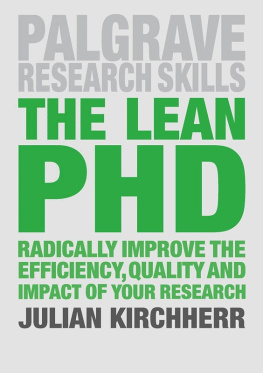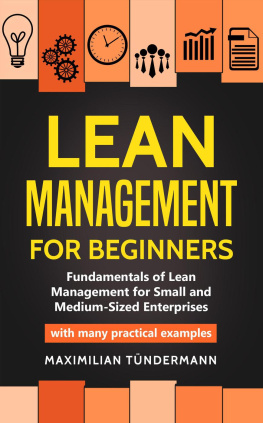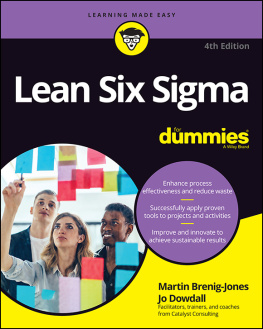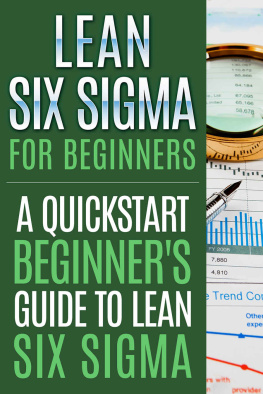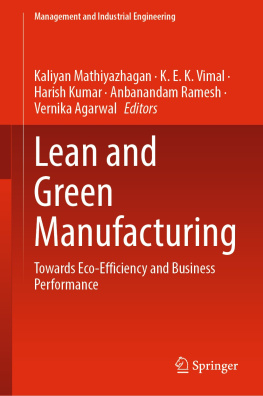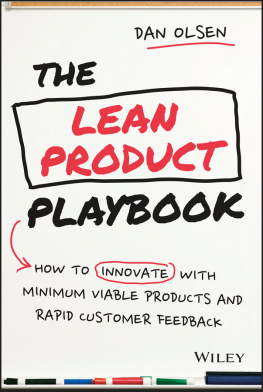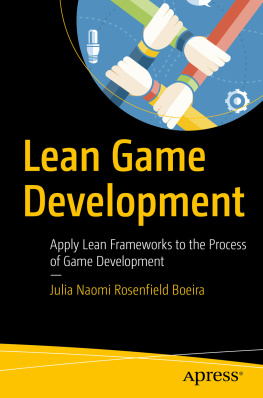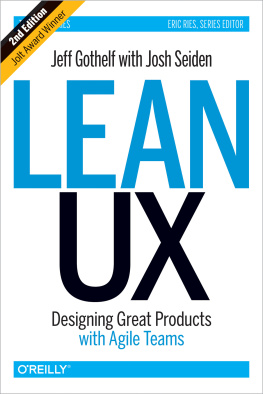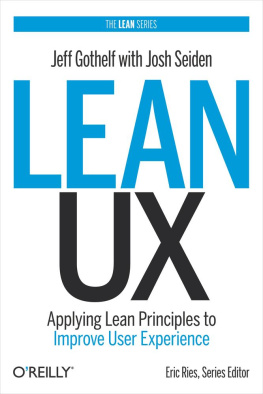The Lean PhD
Palgrave Research Skills
Authoring a PhD
The Foundations of Research (2nd edn)
Getting to Grips with Doctoral Research
Getting Published
The Good Supervisor (2nd edn)
PhD by Published Work
The PhD Viva
Planning Your Postgraduate Research
The Lean PhD
The PhD Writing Handbook
The Postgraduate Research Handbook (2nd edn)
The Professional Doctorate
Structuring Your Research Thesis
Palgrave Teaching and Learning
Series Editor: Sally Brown
Access to Higher Education
Coaching and Mentoring in Higher Education
Facilitating Work-Based Learning
Facilitating Workshops
For the Love of Learning
Fostering Self-Efficacy in Higher Education Students
Internationalization and Diversity in Higher Education
Leading Dynamic Seminars
Learning, Teaching and Assessment in Higher Education
Learning with the Labyrinth
Live Online Learning
Masters Level Teaching, Learning and Assessment
Reimagining Spaces for Learning in Higher Education
Successful University Teaching in Times of Diversity
The Lean PhD
Radically Improve the Efficiency, Quality and Impact of Your Research
Julian Kirchherr

Julian Kirchherr, under exclusive licence to Macmillan Publishers Ltd, part of Springer Nature 2018
All rights reserved. No reproduction, copy or transmission of this publication may be made without written permission.
No portion of this publication may be reproduced, copied or transmitted save with written permission or in accordance with the provisions of the Copyright, Designs and Patents Act 1988, or under the terms of any licence permitting limited copying issued by the Copyright Licensing Agency, Saffron House, 610 Kirby Street, London EC1N 8TS.
Any person who does any unauthorized act in relation to this publication may be liable to criminal prosecution and civil claims for damages.
The author has asserted his right to be identified as the author of this work in accordance with the Copyright, Designs and Patents Act 1988.
First published 2018 by
PALGRAVE
Palgrave in the UK is an imprint of Macmillan Publishers Limited, registered in England, company number 785998, of 4 Crinan Street, London N1 9XW.
Palgrave and Macmillan are registered trademarks in the United States, the United Kingdom, Europe and other countries.
ISBN 9781352002829 paperback
This book is printed on paper suitable for recycling and made from fully managed and sustained forest sources. Logging, pulping and manufacturing processes are expected to conform to the environmental regulations of the country of origin.
A catalogue record for this book is available from the British Library.
A catalog record for this book is available from the Library of Congress.
To Sarah
Contents
List of Illustrative Material
Figures
Tables
Introduction
Pursuing a PhD is a major undertaking. Most universities in Europe claim that completing one will take three to four years.
Despite this considerable time investment, the impact of many completed PhDs is indiscernible at best. Citations are usually seen as the main proxy for academic impact. she is now working in a job that has nothing to do with her PhD or research in general, and comments: I would have been further in my corporate career if I had not done this PhD.
It is questionable that a PhD is a reasonable time investment if it takes more than five years to complete, but is barely noticed by anyone, while not contributing to your career. This book is about turning these PhDs into endeavours that are value-adding for the student pursuing them, and beyond. It aims to explain how to radically improve the efficiency, quality and impact of your research. Its ambition is to fundamentally challenge how PhDs are currently pursued as well as the way we work in contemporary academia. There are so many insights out there these days about how to organize work efficiently and effectively. Sadly, most of these are not widely applied in the academy.
I developed the idea to write this book upon having read Authoring a PhD: How to Plan, Draft, Write, and Finish a Doctoral Thesis or Dissertation, written by Patrick Dunleavy who was one of my professors at the London School of Economics (LSE).
These books all contained helpful bits and pieces on how to go about a PhD. However, I found that they largely focus on the technical and stylistic aspects of the PhD endeavour (I subsume these as technicalities from now on), e.g. helpful citation software to use, ways to present data, ideal length of a paragraph or chapter, typical paper or chapter structures, and different approaches to writing headings and subheadings. For instance, Dunleavy devotes one sub-chapter in his book to principles for presenting data well, while another sub-chapter is dedicated to how to devise headings and even subheadings.7 Undoubtedly, information on these technicalities is essential for mastering a PhD and I thus recommend to readers who are unfamiliar with these points to read at least one of these books.
In my case, I felt that I already knew most of the technicalities. After all, many of them, for example how to present data well or typical paper structures, are already taught at the Bachelors and Masters level. Meanwhile, I was seeking a more comprehensive take: how to organize the entire process of completing a PhD. Yet I did not find this process perspective outlined in any of the books I examined. This book aims to fill this perceived gap. It is not about the technicalities of a PhD. Rather, its ambition is to explain how to best organize the entire PhD process from the very beginning to the very end.
I hope that this book is read by those who are about to embark on a PhD. This book will help you to complete your doctorate much more efficiently than you would have done otherwise, while maximizing the quality and impact that you aim to deliver. However, the ideas presented in it will also aid those who are in the midst of their PhD and those who are about to submit their thesis. Even if you have already submitted your dissertation and are now preparing for your defence, this book may still be worth a read. I also urge PhD supervisors to read this book. After all, the supervisor is a central player in implementing the PhD approach I outline. Indeed, in Chapter 5 of this book I show that many of the working principles outlined are relevant for anyone in the academy including those who are currently writing their Bachelors or Masters thesis.
My completion time was not a coincidence. Rather, it was grounded in a specific approach which I encountered while working in the private sector. This approach revolves around lean methodologies, which I define in detail in Section 1.2. I started learning about these lean methodologies while running a (not particularly successful) early stage start-up in London and Singapore back in 2012 and 2013. I further worked with lean methodologies while at a consultancy firm as a management consultant and project manager from 2013 onwards. This firm was organized around a variety of lean principles, while also offering advice to clients on how to implement these principles.
Lean methodologies are particularly hyped in the start-up community these days; among the entrepreneurs adhering to them, Eric Riess book The Lean Startup has become a bible. Even governments in the most remote parts of the world work along these principles nowadays. I was admitted to my PhD when I was working on a management consultancy project for an Asian provincial government where our team deployed lean methodologies to help it shape and start executing its next five-year development plan. This regional government is now experiencing tremendous success as do so many other organizations that apply these principles. This is what motivated me to try out lean methodologies in the academy.
Next page
